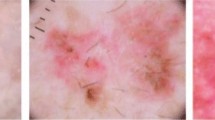Abstract
The skin is a barrier, protecting the body from external factors such as bacteria, viruses, and harmful environmental agents. Healthy skin is a crucial factor in creating an attractive appearance and a source of motivation for personal confidence. Skin conditions can also affect our emotions and mental well-being, with skin problems that can cause stress and self-consciousness. Maintaining skin health helps maintain an appealing outward appearance and plays a vital role in the early detection of health issues such as skin cancer and other dermatological conditions. Using advancements in deep learning has facilitated the diagnosis of various pigmented skin lesions, including actinic keratosis, basal cell carcinoma, seborrheic keratosis, dermatofibroma, malignant melanoma, nevus, and vascular lesions with Deep Residual Networks on images of various sizes. However, traditional methods have limitations in handling large image areas, especially in the presence of noise or complex lesion regions. In this study, we employed ResNet50, VGG16, and InceptionV3 for skin disease diagnosis, showing promising results compared to previous studies. The experimental results demonstrate high performance across accuracy, Area Under the curve, Precision, Recall, and F1-score.
Access this chapter
Tax calculation will be finalised at checkout
Purchases are for personal use only
Similar content being viewed by others
References
Mruthyunjayappa, S., Mahantappa, H., Gopal, M., Venugopal, S.B.: A study of spectrum of histopathological features in patients presenting with hyperpigmented skin lesions. Arch. Med. Health Sci. 4(2), 189–195 (2016)
Thawabteh, A.M., Jibreen, A., Karaman, D., Thawabteh, A., Karaman, R.: A comprehensive review on skin pigmentation-types, causes, and treatment (2023). https://doi.org/10.20944/preprints202305.0751.v1
Kassem, M.A., Hosny, K.M., Damaševičius, R., Eltoukhy, M.M.: Machine learning and deep learning methods for skin lesion classification and diagnosis: a systematic review. Diagnostics 11(8), 1390 (2021). https://doi.org/10.3390/diagnostics11081390
Abunadi, I., Senan, E.M.: Deep learning and machine learning techniques of diagnosis dermoscopy images for early detection of skin diseases. Electronics 10(24), 3158 (2021). https://doi.org/10.3390/electronics10243158
Yilmaz, E., Trocan, M.: Benign and malignant skin lesion classification comparison for three deep-learning architectures. In: Nguyen, N.T., Jearanaitanakij, K., Selamat, A., Trawiński, B., Chittayasothorn, S. (eds.) ACIIDS 2020. LNCS (LNAI), vol. 12033, pp. 514–524. Springer, Cham (2020). https://doi.org/10.1007/978-3-030-41964-6_44
Belaid, O.N., Loudini, M.: Classification of brain tumor by combination of pre-trained VGG16 CNN. J. Inf. Technol. Manag. 12(2), 13–25 (2020). https://doi.org/10.22059/jitm.2020.75788
Jinnai, S., Yamazaki, N., Hirano, Y., Sugawara, Y., Ohe, Y., Hamamoto, R.: The development of a skin cancer classification system for pigmented skin lesions using deep learning. Biomolecules 10(8), 1123 (2020). https://doi.org/10.3390/biom10081123
Wei, Z., Song, H., Chen, L., Li, Q., Han, G.: Attention-based denseunet network with adversarial training for skin lesion segmentation. IEEE Access 7, 136616–136629 (2019)
Ali, R., Hardie, R.C., Narayanan Narayanan, B., De Silva, S.: Deep learning ensemble methods for skin lesion analysis towards melanoma detection. In: 2019 IEEE National Aerospace and Electronics Conference (NAECON). IEEE (2019). https://doi.org/10.1109/NAECON46414.2019.9058245
Yang, Y., et al.: Development and validation of two artificial intelligence models for diagnosing benign, pigmented facial skin lesions. Skin Res. Technol. 27(1), 74–79 (2020). https://doi.org/10.1111/srt.12911
Pham, N.H., Nguyen, H.T., Phan, T.T.: Shallow convolutional neural network configurations for skin disease diagnosis. In: Dao, N.N., Thinh, T.N., Nguyen, N.T. (eds.) ICIT 2023. LNDECT, vol. 187, pp. 370–381. Springer, Cham (2023). https://doi.org/10.1007/978-3-031-46573-4_34
Tschandl, P.: The ham10000 dataset, a large collection of multi-source dermatoscopic images of common pigmented skin lesions (2018). https://doi.org/10.7910/DVN/DBW86T
Ibrahim, A.M., Elbasheir, M., Badawi, S., Mohammed, A., Alalmin, A.F.M.: Skin cancer classification using transfer learning by VGG16 architecture (case study on Kaggle dataset). J. Intell. Learn. Syst. Appl. 15(03), 67–75 (2023). https://doi.org/10.4236/jilsa.2023.153005
Nahata, H., Singh, S.P.: Deep learning solutions for skin cancer detection and diagnosis. In: Jain, V., Chatterjee, J.M. (eds.) Machine Learning with Health Care Perspective. LAIS, vol. 13, pp. 159–182. Springer, Cham (2020). https://doi.org/10.1007/978-3-030-40850-3_8
He, K., Zhang, X., Ren, S., Sun, J.: Deep residual learning for image recognition (2015). https://arxiv.org/abs/1512.03385
Calderón, C., Sanchez, K., Castillo, S., Arguello, H.: BILSK: a bilinear convolutional neural network approach for skin lesion classification. Comput. Methods Programs Biomed. Update 1, 100036 (2021)
Nugroho, A.A., Slamet, I., Sugiyanto, S.: Skins cancer identification system of HAML0000 skin cancer dataset using convolutional neural network. In: AIP Conference Proceedings. AIP Publishing (2019). https://doi.org/10.1063/1.5141652
Ali, K., Shaikh, Z.A., Khan, A.A., Laghari, A.A.: Multiclass skin cancer classification using EfficientNets - a first step towards preventing skin cancer. Neurosci. Inform. 2(4), 100034 (2022). https://doi.org/10.1016/j.neuri.2021.100034
Alam, T.M., et al.: An efficient deep learning-based skin cancer classifier for an imbalanced dataset. Diagnostics 12(9), 2115 (2022). https://doi.org/10.3390/diagnostics12092115
Author information
Authors and Affiliations
Corresponding author
Editor information
Editors and Affiliations
Rights and permissions
Copyright information
© 2024 The Author(s), under exclusive license to Springer Nature Singapore Pte Ltd.
About this paper
Cite this paper
Nguyen, H.T., Ha, C.N., Thi Pham, L.T., Thi-Ngoc-Diem, P., Thanh-Dien, T. (2024). Deep Residual Networks for Pigmented Skin Lesions Diagnosis. In: Fujita, H., Cimler, R., Hernandez-Matamoros, A., Ali, M. (eds) Advances and Trends in Artificial Intelligence. Theory and Applications. IEA/AIE 2024. Lecture Notes in Computer Science(), vol 14748. Springer, Singapore. https://doi.org/10.1007/978-981-97-4677-4_27
Download citation
DOI: https://doi.org/10.1007/978-981-97-4677-4_27
Published:
Publisher Name: Springer, Singapore
Print ISBN: 978-981-97-4676-7
Online ISBN: 978-981-97-4677-4
eBook Packages: Computer ScienceComputer Science (R0)




